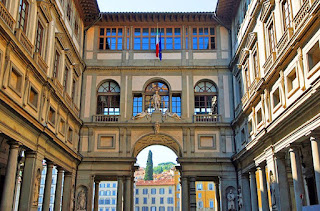
The Uffizi Gallery is an art museum in Florence, Italy that houses some of the world’s most famous works of art, including works by Botticelli, Michelangelo, and Leonardo da Vinci. Cosimo l de’ Medici ordered the museum to be designed and built as the judiciary and administrative offices in Florence in 1560. It was designed in the U-shape that still exists today by Cosimo’s favorite artist, Giorgio Vasari. When Vasari died in 1574, the project was taken over by Bernardo Buontalenti, another well-known artist of the time. Many rooms were designated to exhibit art over the years, and the Uffizi is thought to have served as a recreation and work space for famous artists such as Michelangelo. The Uffizi opened to the public in 1769, making it one of history’s first modern museums.
In 1743, the last Medici heiress, Anna Maria Luisa de’ Medici, bequeathed the majority of the Medici family’s art collection (spanning over 300 years) to the Tuscan State. She insisted on it remaining in Tuscany, specifically in Florence.
The Uffizi Gallery first opened to the public in 1769. It housed a significant portion of the Medici family’s collection.
Vasari, the designer of the Uffizi Gallery, wrote a book about the Uffizi called Lives of the Artists. In it, he mentioned several regular Uffizi patrons, including Leonardo da Vinci and Michelangelo.
Rubens, Raphael, Michelangelo, Leonardo, Botticelli, Titian, Parmigianino, Caravaggio, Rembrandt, Uccello, Lorenzetti, Giotto, Duccio, and Cosimo are among the artists whose work can be found in the Uffizi Gallery.
The Uffizi was built in the shape of a U, with a narrow courtyard between the two wings.
The Uffizi Gallery receives approximately 1.9 million visitors per year, making it one of the most popular in the world. It is so popular that in the summer, lines to enter the museum can last up to 5 hours.
Floods have caused damage to the Uffizi Gallery, including a particularly damaging one in 1966 caused by the rising Arno River.
The first flood in 1966 was so severe that most of Florence’s art collections were severely damaged. Locals, tourists, and anyone else who could helped rushed to save the artwork at various galleries, including the Uffizi. For their successful efforts, they are dubbed “mud angels.”
In 1993, a car bomb exploded outside the Uffizi Gallery. When the car went off between the Uffizi Gallery and the Arno River, it killed five people. Three Uffizi paintings, including Gerard van Honthorst’s Adoration of the Shepherds, were permanently destroyed (1620). It was thought to be mafia-related.
Following the car bombing, the Uffizi was restored, with a bookshop, café, a new wing, and a multimedia information center for visitors.
In 1911, the Mona Lisa was stolen from the Louvre in Paris. It had been missing for two years until thief Vincenzo Peruggia attempted to sell it. When they determined that the painting was genuine, they recovered it from the thief and temporarily hung it at the Uffizi before returning it to the Louvre.









